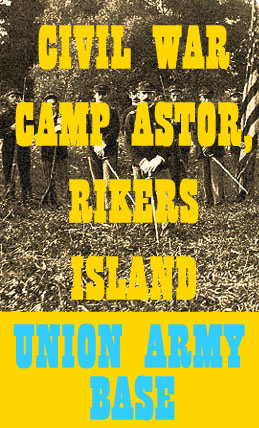
 |  |
|
The Union Army used Riker’s Island during the major portion of the Civil War
years, although the basis for that use, presumably a lease, together with the details of
by whom, to whom, and the terms of payment, has not been found.
A variety of units
and individuals, both volunteer and conscript, served part of their enlistments on the
island and were there for a variety of purposes including mustering in, training,
temporary assignment, and mustering out; and, in addition to its direct use by the
Union Army, toward the end of the war it was used as a prisoner-of-war camp for
captured Confederate Army soldiers.
One of the earliest Union Army regiments on
the island was the New York 76th which was organized in Albany and arrived on the
island on January 21, 1862; a report of this is in a letter that tells about the island
itself and that will be quoted below.
In August until the middle of October of the same
year all of the companies of the 162nd N.Y. Volunteer Infantry Regiment were
The regiment included 795 non-commissioned officers and men plus 150 absentees
for a total strength of 945.
Later in October and November of the same year eleven
companies of the 174th Volunteer Infantry Regiment were recruited in New York
City under the auspices of the metropolitan police and were mustered in to serve for
three years.
This regiment left for Louisiana on December 7, 1862, indicating a
training period on Riker’s Island varying from about seven weeks to less than four
weeks.
While both the 162nd and the 178th Regiments were volunteer units, some of
their members were not content with the island and their first days in the army and
[Continued on Page 42 below.]
|
[Continued from Page 41 above:]
they soon deserted. Among these were such as Richard Hewitt and John Hays; both
enlisted on October 18, but the former deserted just four days later and the latter in five days. Conditions for the men on the island were far from good, as can be gathered from most of the following February 13, 1862, 1etter excerpt:
“Tuesday morning come, and with it the day that saw us leave for Riker’s Island on board
a couple of steam tugs and an old barge. It was an exceedingly cold, raw day, and when we
arrived at the island, we found it minus a single stove, and we had to ‘grin and bear’ it
through all that day and night.
Most of the men went to bed to keep warm, but they
found it freezing under the blankets, as clothing was rather sparse.
The barracks, too,
were built loosely, for summer rather than winter use.
The island, which has become
notorious as the resort of knights of the muscle and pugilists generally .... comprises
about 90 acres of good soil, an orchard, and one dilapidated old house, hired by one
Harry, who keeps inside of it a bar and a family, the number of representatives
deponent knoweth not.
Its climate is miserable cold, uncomfortable, disagreeable and
lonely, and its chief productions, so far as I was able to practically demonstrate, were
oysters, clams ... which the boys amused themselves by digging. In the summer time it
would be a capital place to recreate, to hunt and fish, as wild ducks abound
delightIy, and fish can be obtained in any quantity, but it’s not exactly the spot for
delicate wildlife in the tedious winter time, as the wind whistles Yankee Doodle and
keeps the men dancing an Irish jig continually.”
Of the same mind was A. I. Grover who wrote that
“The hardships of our men began at Albany, in barracks insufficiently warmed, and where
food was provided most disgustingly cooked, and served up in a most disgusting place. The
chapter of hardships was “continued in Rickers Island.”
But at times and for some life on the island was not particularly bad. H. D. Smith wrote
that “we dig clams an Bake them and when we want Oysters we go Down when the
tide is out and knock them off the rocks.”
Levi Havens, belonging to an unspecified
unit and writing in August, 1863, to a brother and sister, was decidedly more upbeat
in the following letter’s excerpts~ in spite of his illness:
“I think you would like to hear from me so I will write a few lines to let you know how I am
and where I am. I am not very well now but am getting better every day.
Last week on
Tuesday I was taken sick with the dysentery and was very sick Friday, Saturday, and
Sunday. I could not eat anything. I had three doctors tend me Sunday. They gave me some
liquor to drink and it did me good. I began to get hungry and they gave me some rice to eat,
so I am getting better now.
I am on Riker’s Island four miles from New York City. I have a
board for my bed, a blanket to roll myself up in, a nice tent to sleep in, and plenty to eat -
- beef and bread, effey [difficult transcription but perhaps coffee] and sometimes ham
and potatoes and sometimes cheese...
In 1863 and again in 1864 Lieut. George Washington Baker, a member of Company K of the 123rd New York Volunteers, wrote letters from Riker's Island, but the circumstances of his being there are not clear. Draft riot occurred in 1863 in New York City as well as in Troy and Boston, and on July 13 James N. Fry, Provost [In printed book, the text continues on Page 43.]
|
home page |
USCTs |
Civil War letters | Civil War prisons |
terrorists in NYC |
|
| ||||